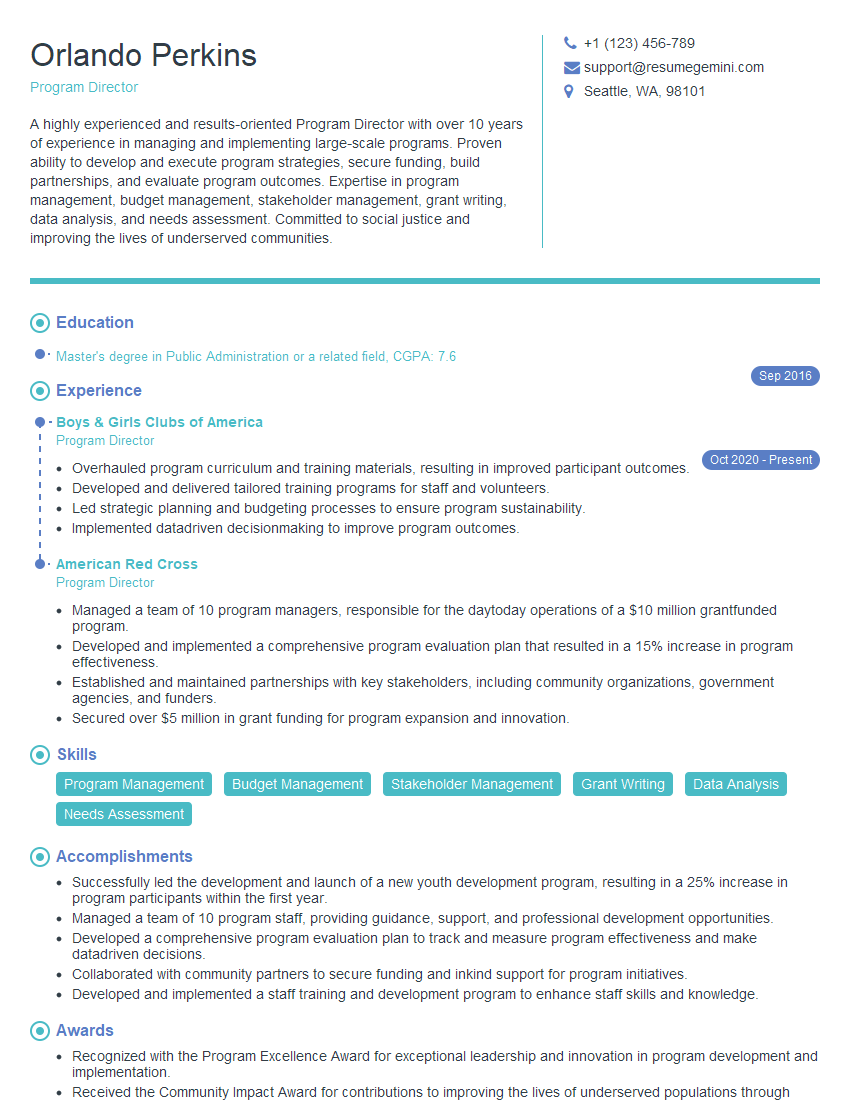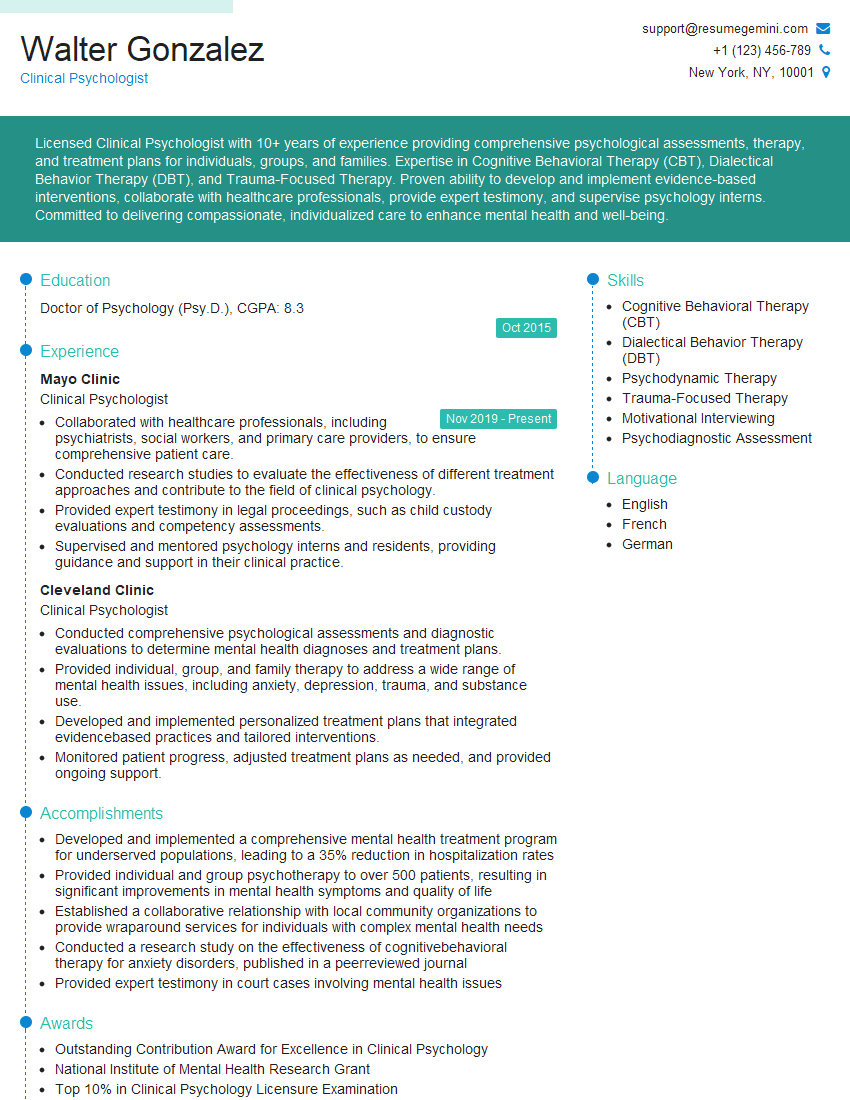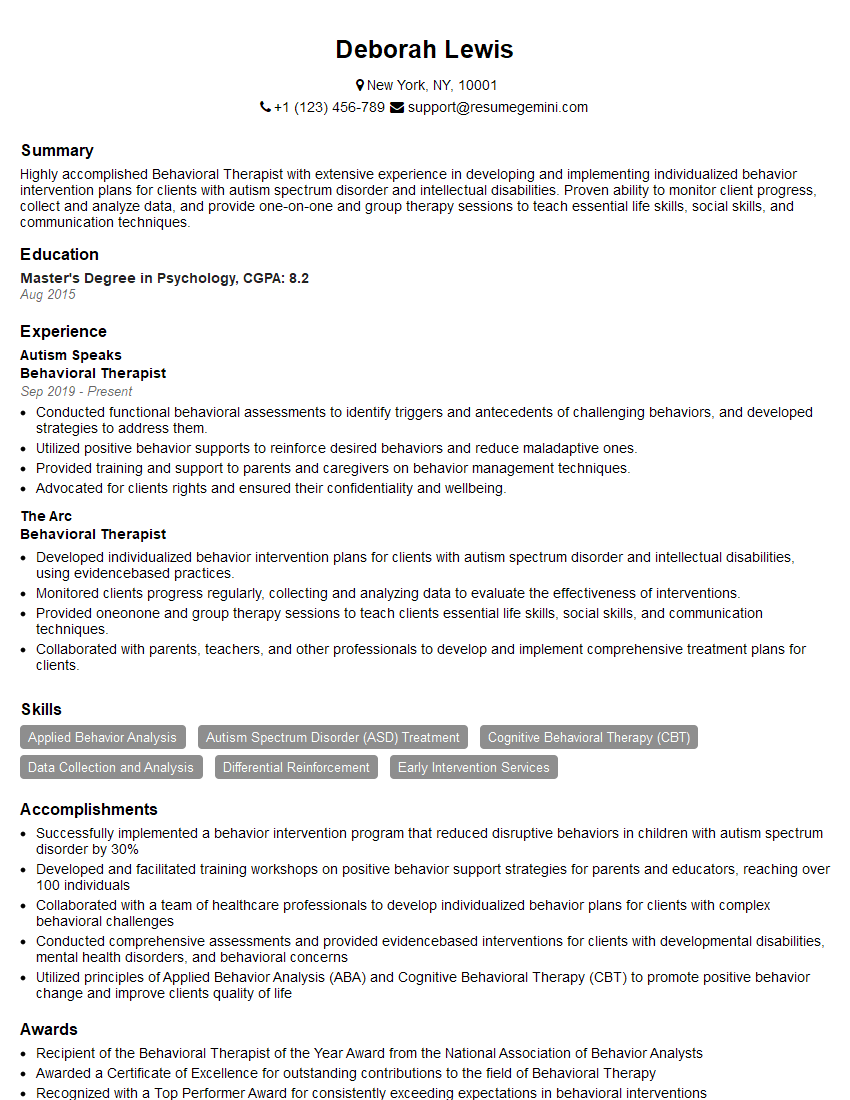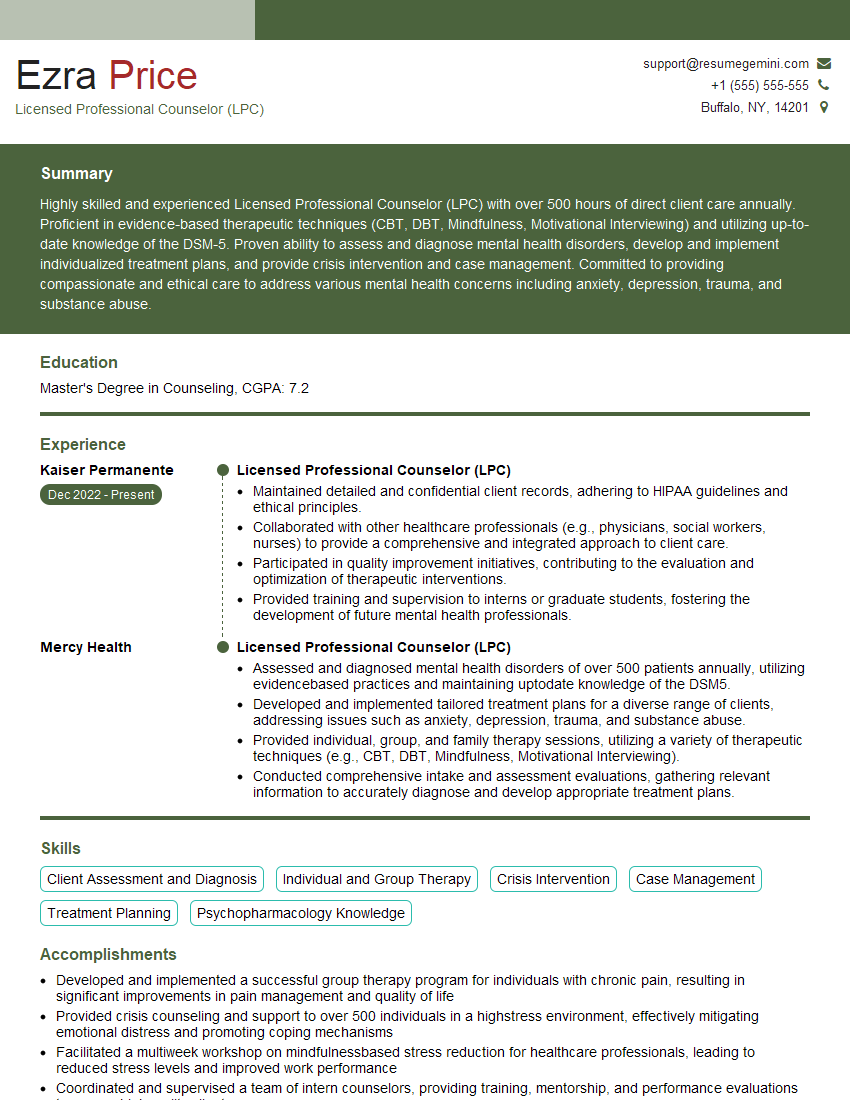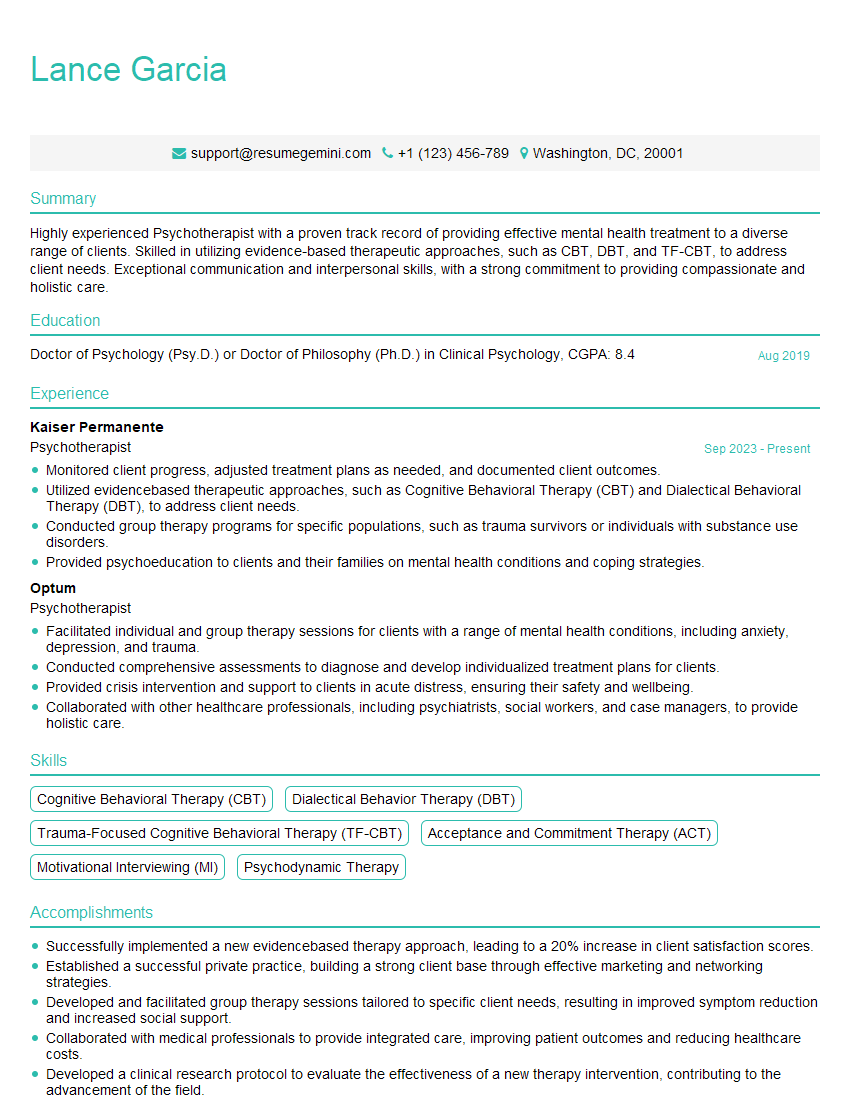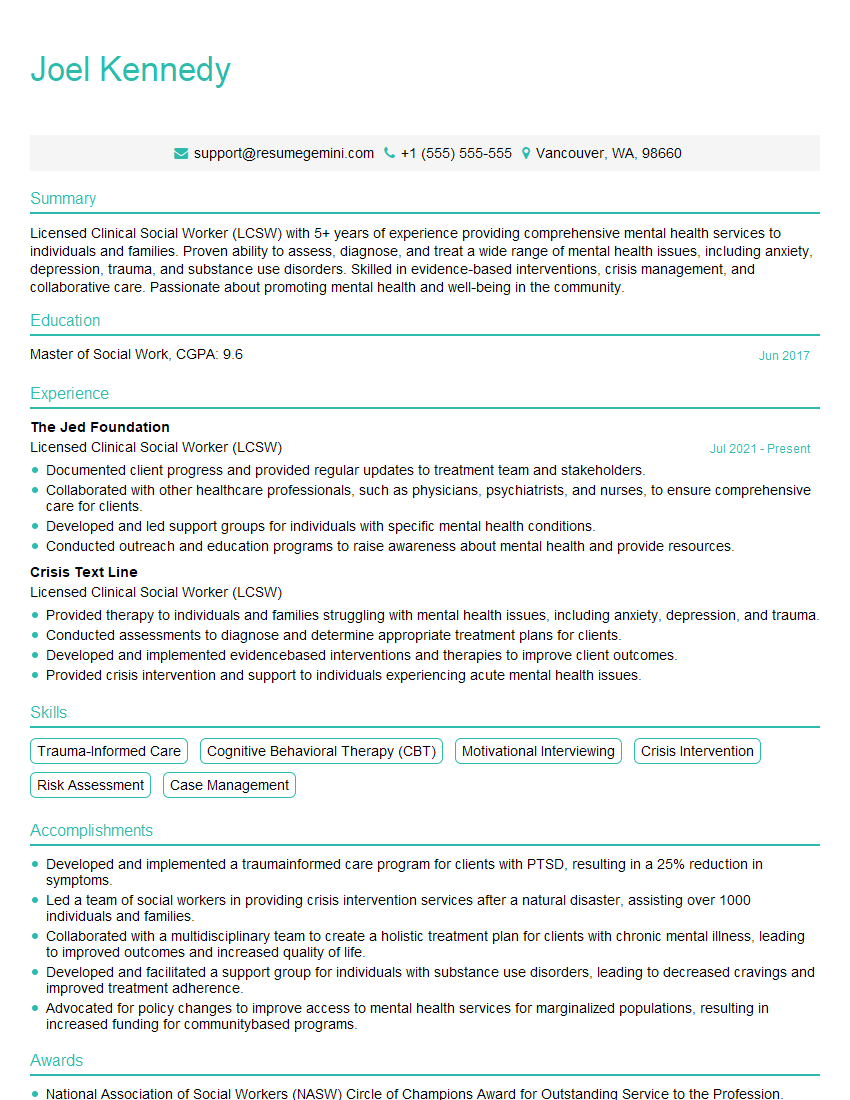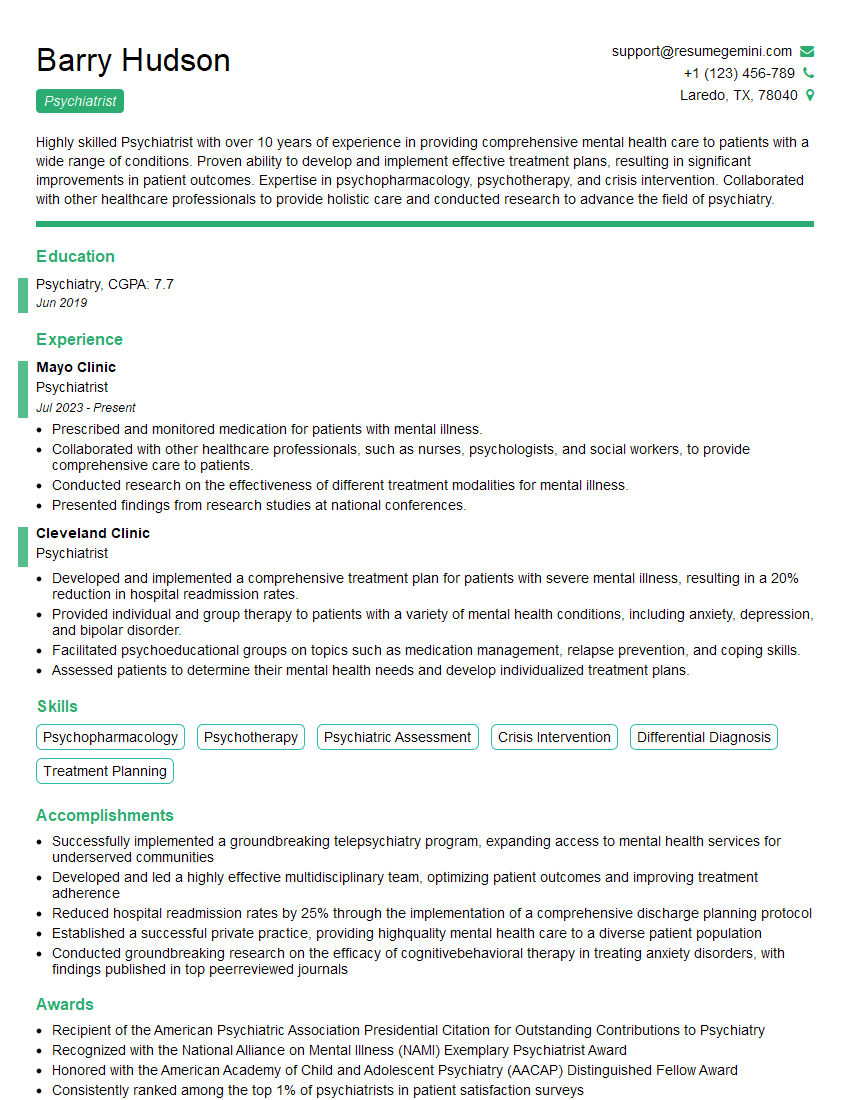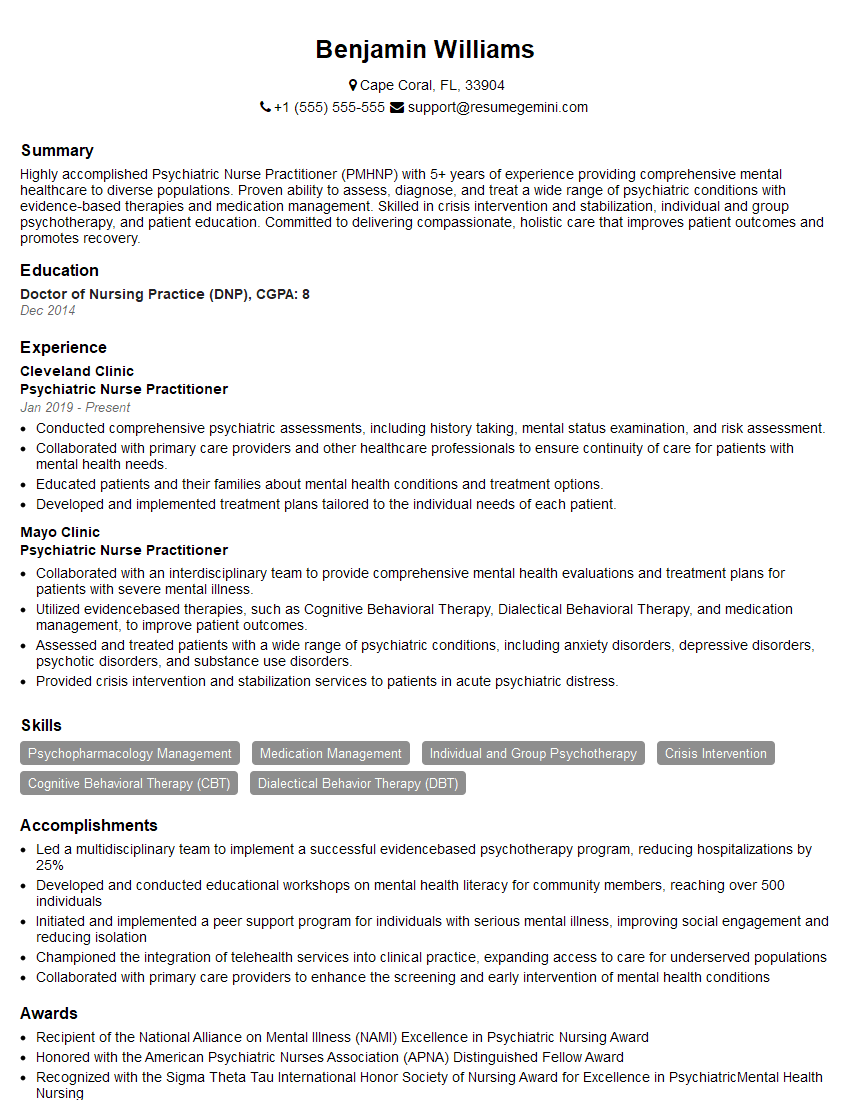Unlock your full potential by mastering the most common Personality Disorders Treatment interview questions. This blog offers a deep dive into the critical topics, ensuring you’re not only prepared to answer but to excel. With these insights, you’ll approach your interview with clarity and confidence.
Questions Asked in Personality Disorders Treatment Interview
Q 1. Describe your experience diagnosing personality disorders using DSM-5 criteria.
Diagnosing personality disorders using the DSM-5 criteria requires a comprehensive and nuanced approach. It’s not a simple checklist; it involves integrating multiple sources of information, including the patient’s self-report, observations of their behavior in sessions, collateral information from family members or other professionals, and a thorough review of their history. The DSM-5 emphasizes a dimensional approach, meaning that the severity of personality traits is considered rather than simply the presence or absence of a disorder. I begin by conducting a thorough clinical interview, exploring the individual’s patterns of thinking, feeling, and behaving across various life domains. I meticulously assess for the enduring patterns of inner experience and behavior that deviate markedly from the expectations of the individual’s culture and lead to clinically significant distress or impairment in social, occupational, or other important areas of functioning. This assessment takes into account the specific criteria outlined for each personality disorder in the DSM-5, paying particular attention to the severity and pervasiveness of the symptoms.
For example, in assessing for Borderline Personality Disorder, I look for a pervasive pattern of instability in interpersonal relationships, self-image, and affects, as well as marked impulsivity, beginning by early adulthood and present in a variety of contexts. This assessment is crucial to determine not only the presence but also the severity of the disorder. This dimensional approach allows for more tailored treatment planning and a more holistic view of the patient’s difficulties. Incorrect diagnosis can lead to ineffective or even harmful interventions, hence the careful and comprehensive assessment process is paramount.
Q 2. Explain the differences between borderline, narcissistic, and antisocial personality disorders.
Borderline, narcissistic, and antisocial personality disorders, while distinct, can share some overlapping features, making differentiation crucial.
- Borderline Personality Disorder (BPD) is characterized by instability in interpersonal relationships, self-image, and affect, alongside impulsivity. Individuals with BPD often fear abandonment, experience intense and rapidly shifting emotions, and engage in self-destructive behaviors. Imagine a patient who intensely loves their therapist one day, and then utterly despises them the next, demonstrating the instability.
- Narcissistic Personality Disorder (NPD) is marked by a grandiose sense of self-importance, a need for admiration, and a lack of empathy. They may exploit others to achieve their goals, and criticism can trigger intense shame or rage. An example might be a colleague who constantly seeks praise, takes credit for others’ work, and becomes enraged when their contributions are not recognized.
- Antisocial Personality Disorder (ASPD) involves a disregard for and violation of the rights of others. Individuals with ASPD often show a pattern of deceitfulness, impulsivity, irritability, and aggression, with a lack of remorse. Think of someone who consistently lies, manipulates others for personal gain, and shows no concern for the consequences of their actions.
The key differences lie in the central motivations and behavioral manifestations. BPD centers on instability and fear of abandonment, NPD on a need for admiration and a lack of empathy, and ASPD on a disregard for social norms and the rights of others. However, comorbidity is common, meaning individuals can have features of more than one personality disorder. A thorough assessment considering all these facets is crucial for accurate diagnosis and effective treatment planning.
Q 3. What therapeutic approaches are most effective for treating borderline personality disorder?
Dialectical Behavior Therapy (DBT) is widely considered the most effective evidence-based treatment for Borderline Personality Disorder (BPD). Other therapies, such as Schema Therapy and Mentalization-Based Treatment, also show promising results. DBT, however, stands out due to its comprehensive approach.
DBT targets several key areas simultaneously. It includes individual therapy focusing on reducing self-destructive behaviors, improving emotional regulation, and strengthening interpersonal skills. Skills training groups are vital, teaching mindfulness, distress tolerance, emotion regulation, and interpersonal effectiveness. These skills give clients practical tools to manage their emotions and relationships. The therapist also offers phone coaching, allowing clients to contact them between sessions for support in managing crises. This approach recognizes the frequent emotional dysregulation in BPD, providing constant support to prevent crises.
For example, a client might learn mindfulness techniques in group therapy to help ground them when experiencing intense emotions. Individual therapy might explore underlying trauma contributing to their self-harm behaviors. Phone coaching could provide immediate guidance when the client feels overwhelmed and at risk of self-injury. The combination of individual therapy, skills training, and phone coaching creates a holistic approach addressing both the emotional dysregulation and the behavioral manifestations of BPD.
Q 4. How do you address splitting in clients with borderline personality disorder?
Splitting, a hallmark of BPD, involves seeing people as either entirely good or entirely bad, with little room for nuance or complexity. Addressing splitting requires a multifaceted approach. First, I validate the client’s feelings without necessarily agreeing with their polarized perceptions. I might acknowledge the hurt they feel but gently point out that their perception may be an oversimplification of a complex situation.
Secondly, I help the client identify the triggers that lead to splitting. Often, these are linked to feelings of abandonment or rejection. By understanding the triggers, we can develop strategies to manage them effectively. This might involve practicing mindfulness techniques to stay grounded during stressful interactions or using communication skills to express needs more assertively, reducing the risk of feeling abandoned or rejected.
Thirdly, I help the client develop a more balanced and nuanced perspective. This is a gradual process that takes time and involves actively challenging the polarized thinking. I encourage the client to consider other perspectives and look for the good qualities even in people who initially trigger a negative reaction. For instance, if a client is splitting a friend, labeling them as “totally bad,” we would collaboratively explore the individual’s potential positive qualities, gradually fostering a more balanced perception.
Finally, the therapeutic relationship itself plays a critical role. Maintaining a consistent and predictable therapeutic presence helps the client develop trust and experience a more stable, non-splitting relationship.
Q 5. Describe your experience using dialectical behavior therapy (DBT).
My experience with Dialectical Behavior Therapy (DBT) has been extensive and deeply rewarding. I’ve found it exceptionally effective in helping clients with BPD manage their intense emotions, improve interpersonal relationships, and reduce self-destructive behaviors. I typically use a structured approach, incorporating individual therapy, skills training groups, and phone coaching as core components.
In individual therapy, I work with clients to identify and challenge maladaptive thought patterns and behaviors contributing to their distress. We collaboratively develop strategies for managing intense emotions and improving their interpersonal skills. Skills training groups provide a supportive environment for learning and practicing essential skills like mindfulness, distress tolerance, emotion regulation, and interpersonal effectiveness.
Phone coaching is a critical aspect, providing immediate support during crises or challenging situations. It fosters a strong therapeutic alliance, facilitating engagement and adherence to the treatment plan. I’ve observed significant reductions in self-harm, suicidal ideation, and hospitalizations in clients engaged in DBT. The ability to quickly intervene during crises is crucial for preventing catastrophic outcomes, making phone coaching an indispensable part of the DBT approach.
For example, one client with severe self-harming behaviors, who was frequently hospitalized, experienced a dramatic decrease in self-harm incidents and hospitalizations after participating in DBT for several months. This was due to a combination of learning coping skills, gaining emotional regulation, and having immediate support through phone coaching. DBT’s effectiveness stems from its comprehensive and collaborative nature, offering both immediate support and long-term tools for managing challenges.
Q 6. What are the key components of schema therapy?
Schema therapy is a long-term psychodynamic therapy that focuses on identifying and modifying maladaptive schemas – deeply ingrained patterns of thinking and feeling developed early in life that significantly impact current functioning. It posits that these schemas, originating from unmet childhood needs, drive dysfunctional behaviors and emotions.
Key components include:
- Schema identification: Through questionnaires and in-depth exploration of the client’s history, maladaptive schemas are identified. These schemas represent unmet needs such as security, autonomy, connection, or competence.
- Schema analysis: The origins and impact of these schemas are explored. We trace them back to early childhood experiences and assess how they manifest in the present day.
- Schema restructuring: Once understood, schemas are challenged and modified through techniques like cognitive restructuring, behavioral experiments, and imagery work. The goal is not to erase the schemas but to modify their impact, empowering the client to manage them more effectively.
- Mode work: Schema therapy recognizes that different aspects of the self may be associated with specific schemas. Mode work involves helping clients understand and manage these different aspects of themselves.
- Limiting schema-driven behaviors: The therapy also helps clients limit actions and reactions fueled by these maladaptive schemas.
For example, a client with an early abandonment schema might consistently sabotage relationships due to a fear of intimacy and rejection. Schema therapy would help the client understand this schema’s origins, challenge the irrationality of its predictions, and develop coping strategies to manage their fear, ultimately leading to healthier relationships.
Q 7. How do you manage transference and countertransference in the context of personality disorders?
Transference and countertransference are inevitable in the therapeutic relationship, especially when working with individuals with personality disorders. Transference refers to the client unconsciously projecting feelings and experiences from past relationships onto the therapist. Countertransference refers to the therapist’s unconscious emotional reactions to the client.
Managing these phenomena requires self-awareness and careful monitoring. Regular supervision is crucial to process personal reactions and maintain objectivity. Recognizing transference and countertransference isn’t about eliminating them, but rather about understanding their influence and using this understanding to deepen the therapeutic work. When a client’s transference becomes disruptive or significantly impedes therapy, I might explore it with the client, helping them understand the origins of the projections. The goal isn’t to resolve transference, but to use it as a tool for insight and growth.
For example, if a client with BPD consistently reacts to me with intense anger, mirroring past experiences of betrayal, I can use this as an opportunity to understand their pattern of relating and address the underlying fears. Similarly, if I experience countertransference, such as feeling intensely frustrated by a client’s manipulative behaviors, I would seek supervision to help me understand my emotional response, maintain appropriate boundaries, and develop strategies to respond effectively, ensuring the therapy remains focused on the client’s needs.
Maintaining regular self-reflection, seeking supervision, and adhering to ethical guidelines are essential for managing transference and countertransference in therapy with individuals experiencing personality disorders. These are not obstacles but opportunities to enhance understanding and promote therapeutic progress.
Q 8. Explain your approach to working with clients who exhibit manipulation or aggression.
Working with clients exhibiting manipulation or aggression requires a multifaceted approach prioritizing safety and therapeutic progress. It’s crucial to establish clear boundaries from the outset, consistently enforcing them to prevent exploitation or escalation. This doesn’t mean being punitive; rather, it involves calmly and firmly addressing inappropriate behavior, explaining its impact, and offering alternative ways of expressing needs.
For example, if a client uses manipulative tactics to get their way, I might say, “I understand you’re frustrated, but demanding isn’t effective. Let’s explore other ways to communicate your needs.” Simultaneously, I’d employ techniques like Cognitive Behavioral Therapy (CBT) to help them identify the underlying thoughts and emotions driving their behavior and develop healthier coping mechanisms. In cases of aggression, a safety plan is vital, outlining steps to de-escalate situations and ensure the safety of both the client and myself. This could involve creating a safe space, utilizing verbal de-escalation techniques, or, in extreme cases, collaborating with the treatment team to implement stricter safety measures. For example, if physical aggression is a concern, we might involve security personnel or a crisis intervention team.
- Clear Boundaries: Communicating expectations and consequences consistently.
- CBT Techniques: Identifying and challenging maladaptive thought patterns.
- De-escalation Strategies: Using calm communication and appropriate interventions.
- Safety Planning: Proactive measures to minimize risks.
Q 9. How do you assess the risk of self-harm or suicide in clients with personality disorders?
Assessing suicide risk in clients with personality disorders requires a thorough and multi-pronged approach. It’s not simply about asking if they are suicidal; it’s about understanding the underlying factors contributing to their distress and the level of their intent. I utilize various assessment tools, including standardized questionnaires like the Suicide Risk Assessment Scale, as well as conducting detailed clinical interviews. These interviews delve into their current mood, thoughts, plans, and access to lethal means. The presence of hopelessness, impulsivity, and recent stressors significantly elevates risk. For example, a client with borderline personality disorder who has recently experienced a relationship breakup and is expressing intense self-loathing might be at high risk.
It’s also important to consider the client’s history of self-harm or suicide attempts. Each attempt, regardless of success, increases the likelihood of future attempts. The assessment should also involve exploring protective factors such as strong social support, positive coping mechanisms, and a sense of purpose. Based on the assessment, I collaborate with the treatment team to develop a tailored safety plan, which might include increased frequency of sessions, hospitalization, or medication adjustments. I believe regular monitoring and open communication are crucial throughout the treatment process.
Q 10. Describe your experience collaborating with other professionals in a treatment team.
Collaboration is essential in treating personality disorders. I frequently work with psychiatrists, nurses, case managers, and other therapists. Regular team meetings are vital for sharing information, coordinating treatment plans, and addressing challenges. This collaborative approach ensures comprehensive care. For example, I might consult with a psychiatrist regarding medication management, collaborating on adjustments to address symptoms that interfere with therapy. With case managers, we work together to coordinate resources like housing or financial assistance, recognizing that social stability directly impacts mental health. Open communication and shared decision-making are crucial to achieving the best possible outcomes.
I’ve found that effective team collaboration relies on clear communication, mutual respect, shared goals, and a willingness to listen to diverse perspectives. Regular documentation and updates ensure continuity of care, especially during transitions between different settings or team members.
Q 11. How do you adapt treatment approaches to clients from diverse cultural backgrounds?
Treating clients from diverse cultural backgrounds requires cultural sensitivity and humility. It’s imperative to avoid imposing my own cultural framework and instead understand how the client’s cultural background influences their understanding of mental health, illness, and treatment. This involves actively listening to their experiences and perspectives, and adapting treatment approaches accordingly. For example, some cultures may have different interpretations of emotional expression or have unique family structures and dynamics that should be considered when tailoring treatment. It is also important to acknowledge that some treatments might not be universally applicable. Therefore, I incorporate culturally appropriate approaches and interventions whenever possible. This may involve incorporating traditional healing practices or selecting interventions that resonate with the client’s beliefs and values.
Consultations with cultural experts or community leaders can be valuable when working with individuals whose cultural norms differ significantly from my own. This ensures that I am providing culturally sensitive and appropriate care. A thorough cultural assessment that acknowledges the client’s beliefs, values, and preferred communication styles is essential in establishing trust and rapport.
Q 12. What are the ethical considerations when treating individuals with personality disorders?
Ethical considerations in treating personality disorders are paramount. Maintaining client confidentiality is crucial, particularly given the potential for clients to disclose sensitive information. There might be situations where legal considerations, such as mandatory reporting of abuse or self-harm, necessitate careful balance between confidentiality and duty of care. Setting clear boundaries is also critical to prevent boundary violations and maintain professional integrity. The therapeutic relationship should always be strictly professional, avoiding dual relationships or any actions that could compromise the client’s wellbeing or exploit the power dynamic inherent in the therapist-client relationship.
Informed consent is another key ethical consideration. It means clients must thoroughly understand the nature of the treatment, its risks and benefits, and their rights before engaging in therapy. This necessitates clear, transparent communication, ensuring the client’s capacity to consent is fully considered. Regular supervision and peer consultation help ensure ethical conduct and prevent potential pitfalls. Engaging in ongoing professional development ensures that I am up-to-date on best practices and ethical guidelines.
Q 13. How do you set boundaries with clients who have personality disorders?
Setting boundaries with clients who have personality disorders is crucial for both their well-being and the therapist’s professional integrity. It’s important to establish these boundaries clearly and consistently from the initial sessions. This involves defining the parameters of the therapeutic relationship, such as session times, communication protocols (e.g., email vs. phone), and expectations regarding appropriate behavior. For instance, I would clearly communicate my availability and expectations regarding appointment cancellations or missed sessions.
It’s also essential to manage requests outside the therapy session. While empathy is essential, it is equally important to maintain professional boundaries by gently but firmly redirecting requests that are not appropriate or fall outside the scope of the therapeutic relationship. For example, if a client calls incessantly outside of scheduled sessions, I’ll address this directly while reassuring them about the structure and support available within sessions. Consistently enforcing boundaries ensures a safe and effective therapeutic environment, reducing the likelihood of manipulation or boundary violations.
Q 14. Describe your experience with medication management in the context of personality disorders.
Medication management for personality disorders is usually done in collaboration with a psychiatrist. While there’s no specific medication to treat personality disorders themselves, medications can effectively manage co-occurring symptoms like anxiety, depression, or impulsivity. These medications can significantly enhance the effectiveness of psychotherapy. For example, antidepressants might be prescribed to address comorbid depression, while mood stabilizers can help manage impulsivity and emotional dysregulation. Antipsychotics might be considered for severe psychotic symptoms that sometimes occur in some personality disorders.
My role involves communicating closely with the psychiatrist, providing ongoing updates on the client’s progress in therapy. This collaborative approach involves regularly discussing the client’s response to medication, identifying potential side effects, and adjusting treatment plans as needed. It’s essential to emphasize that medication is a supportive tool, not a standalone solution. Effective treatment usually involves a combination of medication management and psychotherapy, with ongoing monitoring and adjustments to optimize outcomes.
Q 15. What are the challenges in treating personality disorders, and how do you address them?
Treating personality disorders presents unique challenges due to the deeply ingrained and pervasive nature of the personality patterns. These patterns affect how individuals perceive themselves, others, and the world, impacting their relationships and overall functioning. Key challenges include:
- Resistance to change: Individuals may not see their personality traits as problematic or be unwilling to acknowledge the need for change.
- Difficulties in forming a therapeutic alliance: The very patterns that characterize the disorder can hinder the development of a trusting and collaborative relationship with the therapist.
- Comorbid conditions: Personality disorders often co-occur with other mental health issues, like depression, anxiety, or substance use disorders, complicating treatment.
- Lengthy treatment process: Significant and lasting change requires considerable time and effort from both the client and therapist.
Addressing these challenges involves employing specific strategies:
- Building a strong therapeutic alliance: This requires patience, empathy, and a collaborative approach. Establishing a safe and validating environment is crucial.
- Motivational interviewing techniques: These methods help to explore and resolve ambivalence about change and facilitate engagement in therapy.
- Dialectical Behavior Therapy (DBT) and Schema Therapy: These evidence-based treatments target specific maladaptive behaviors and underlying schemas (belief systems) that contribute to the disorder.
- Collaborative case management: Coordinating care with other professionals, such as psychiatrists or family therapists, addresses comorbid conditions and provides comprehensive support.
- Setting realistic goals and expectations: Focusing on small, achievable steps can help prevent discouragement and promote a sense of accomplishment.
Career Expert Tips:
- Ace those interviews! Prepare effectively by reviewing the Top 50 Most Common Interview Questions on ResumeGemini.
- Navigate your job search with confidence! Explore a wide range of Career Tips on ResumeGemini. Learn about common challenges and recommendations to overcome them.
- Craft the perfect resume! Master the Art of Resume Writing with ResumeGemini’s guide. Showcase your unique qualifications and achievements effectively.
- Don’t miss out on holiday savings! Build your dream resume with ResumeGemini’s ATS optimized templates.
Q 16. How do you measure treatment progress and outcomes in personality disorder treatment?
Measuring progress and outcomes in personality disorder treatment is complex, as the changes are often subtle and take time to manifest. It’s crucial to use a multi-faceted approach:
- Self-report measures: Questionnaires and scales assessing personality traits, symptom severity, and quality of life provide quantitative data on changes over time. Examples include the Personality Diagnostic Questionnaire-4 (PDQ-4) and the Shedler-Westen Assessment Procedure (SWAP).
- Clinical observation: Regular assessments by the therapist offer qualitative insights into changes in behavior, interpersonal functioning, and overall well-being.
- Objective measures: Data gathered from family members, significant others, or workplace settings can provide corroborating evidence of change.
- Functional assessment: Monitoring changes in adaptive functioning, such as improved relationships, work performance, or social engagement, is critical.
It’s essential to use a combination of these methods to get a complete picture of treatment progress. A reduction in symptom severity, improved interpersonal relationships, enhanced self-esteem, and increased overall functioning all indicate successful treatment, although the degree of improvement varies considerably depending on the individual and the severity of the disorder.
Q 17. Explain your understanding of the role of family therapy in treating personality disorders.
Family therapy plays a crucial role in treating personality disorders, particularly when family dynamics have contributed to the development or maintenance of the disorder. It’s not always suitable for all cases, but it can be highly effective when appropriate.
The approach aims to:
- Improve family communication and interaction patterns: Addressing dysfunctional communication styles and conflict resolution strategies within the family system.
- Increase understanding and empathy among family members: Helping family members understand the impact of the personality disorder on each other and fostering a more supportive environment.
- Identify and address family stressors: Addressing underlying family issues and conflict that may trigger or exacerbate symptoms.
- Empower family members to support treatment: Educating and equipping family members with the knowledge and skills to support the individual in their recovery.
For example, in a family where a daughter with borderline personality disorder experiences intense emotional dysregulation, family therapy might focus on helping parents learn to respond to her emotional outbursts in a more validating and less reactive way, teaching her more adaptive coping skills to manage her emotions and improving overall family communication and support.
Q 18. How do you handle resistance to treatment in clients with personality disorders?
Resistance to treatment is common in personality disorders. Addressing it requires a sensitive and understanding approach. It’s crucial to avoid confrontation and instead engage the client in a collaborative process.
Strategies include:
- Understanding the underlying reasons for resistance: Exploring the client’s concerns, fears, and anxieties about therapy and change.
- Validating the client’s perspective: Acknowledging and accepting the client’s feelings, even if they seem illogical or unreasonable.
- Collaboratively setting goals: Working with the client to set realistic and achievable goals that they are invested in.
- Focusing on small, manageable steps: Breaking down larger goals into smaller, more manageable steps can increase motivation and reduce feelings of overwhelm.
- Utilizing motivational interviewing techniques: Employing strategies to help clients identify their own reasons for change and strengthen their commitment to treatment.
- Reframing resistance as a sign of engagement: Viewing resistance as an opportunity to understand the client’s difficulties better and work collaboratively to address them.
It’s important to remember that change takes time, and progress is not always linear. Patience and persistence are essential when dealing with resistance.
Q 19. How do you address comorbid conditions commonly associated with personality disorders?
Personality disorders often co-occur with other mental health conditions. This comorbidity significantly impacts the course and treatment of the personality disorder. Effective management requires a comprehensive approach addressing both the personality disorder and the comorbid conditions.
For instance, if a client has borderline personality disorder and depression, treatment might involve:
- Medication management: Psychiatric consultation to address the depressive symptoms with antidepressants. This can improve mood, reduce emotional dysregulation, and enhance the client’s ability to participate in therapy.
- Psychotherapy targeting both disorders: Employing therapies such as DBT or Schema Therapy that specifically address the core symptoms of borderline personality disorder while also incorporating strategies to manage depression, like cognitive behavioral therapy (CBT) techniques.
- Integrated treatment planning: A collaborative effort between therapists and psychiatrists to ensure that treatment goals and strategies are aligned for both conditions.
- Monitoring for treatment response and adjustment: Regularly assessing the efficacy of treatment for both conditions, adjusting strategies as needed.
The specific approach depends on the individual’s unique needs and the specific comorbid conditions present. It often requires a team approach, involving psychiatrists, therapists, and other healthcare professionals, to provide the most effective and comprehensive care.
Q 20. Describe a challenging case involving a personality disorder and how you successfully managed it.
I once worked with a client, Sarah, who presented with histrionic personality disorder and severe anxiety. She engaged in dramatic, attention-seeking behaviors, frequently experienced intense emotional swings, and had difficulty maintaining stable relationships. Her anxiety significantly hampered her daily functioning.
Initially, Sarah was highly resistant to therapy, believing her behaviors were normal and others were responsible for her difficulties. I employed a combination of strategies to manage this case successfully:
- Building rapport and establishing trust: Focusing on empathetic listening and validation helped build a therapeutic alliance, despite her initial resistance.
- Utilizing cognitive behavioral therapy (CBT): We addressed her maladaptive thought patterns contributing to her anxiety and attention-seeking behaviors, helping her identify and challenge these thoughts.
- Dialectical behavior therapy (DBT) skills training: This proved especially helpful in managing her emotional dysregulation and improving her interpersonal skills.
- Focusing on self-awareness: Helping her recognize the patterns of her behavior and their impact on her relationships was vital in motivating her to change.
Over time, Sarah demonstrated significant progress. Her anxiety reduced considerably, she learned to regulate her emotions more effectively, and she developed healthier coping mechanisms. She improved her relationships and demonstrated increased self-awareness, showing a greater capacity for emotional stability and healthier interpersonal interactions. It was a long process but highlighted the importance of patience, tailoring therapy to the client’s specific needs, and utilizing evidence-based practices.
Q 21. What are your views on the long-term prognosis for clients with personality disorders?
The long-term prognosis for clients with personality disorders is variable and depends on several factors, including the specific personality disorder, the severity of symptoms, the presence of comorbid conditions, and the client’s engagement with treatment.
While complete symptom remission is not always achievable, significant improvements in functioning are possible with appropriate and sustained treatment. Many individuals with personality disorders experience substantial reductions in symptom severity, improved interpersonal relationships, increased emotional regulation, and enhanced overall quality of life. The focus often shifts from complete “cure” to managing symptoms and maximizing functional capacity.
Factors that improve prognosis include early intervention, consistent participation in evidence-based therapies, strong therapeutic alliance, effective management of comorbid conditions, a supportive social network, and the individual’s personal commitment to change. Regular follow-up care is often essential to maintain progress and address any relapses.
Q 22. What continuing education or professional development activities have you pursued related to personality disorders?
My commitment to ongoing professional development in personality disorders is unwavering. I regularly attend conferences such as those offered by the American Psychological Association (APA) and the International Society for the Study of Personality Disorders (ISSPD), focusing on workshops and presentations covering the latest research and treatment modalities. For example, I recently completed a specialized training program on Dialectical Behavior Therapy (DBT) for borderline personality disorder, which significantly enhanced my therapeutic skills. Additionally, I actively participate in continuing education courses focusing on specific personality disorders like narcissistic personality disorder and obsessive-compulsive personality disorder, ensuring my knowledge base remains current and comprehensive. I also engage in peer supervision groups, where we discuss complex cases and refine our treatment approaches collaboratively. This continuous learning allows me to provide the most effective and up-to-date care for my patients.
Q 23. Explain your experience with specific assessment tools used in personality disorder diagnosis.
Accurate diagnosis of personality disorders requires a thorough assessment process. I utilize several evidence-based tools, including structured clinical interviews such as the Structured Clinical Interview for DSM-5 Personality Disorders (SCID-5-PD). This interview provides a standardized approach, minimizing bias and ensuring reliability in diagnosing various personality disorders according to DSM-5 criteria. I also frequently employ self-report questionnaires like the Millon Clinical Multiaxial Inventory (MCMI) and the Personality Assessment Inventory (PAI). These tools offer valuable insights into the client’s personality traits and psychopathology. Crucially, I don’t rely solely on these instruments. I integrate the information gathered from these assessments with my clinical judgment, considering the client’s history, presenting symptoms, and interpersonal relationships. The combination of structured interviews and self-report measures provides a comprehensive picture of the client’s personality functioning, facilitating a more accurate and nuanced diagnosis.
Q 24. How do you incorporate evidence-based practices into your treatment approach for personality disorders?
Evidence-based practices are central to my treatment approach for personality disorders. My work is grounded in empirically supported therapies such as Dialectical Behavior Therapy (DBT), Schema Therapy, and Transference-Focused Psychotherapy. For instance, in treating a client with borderline personality disorder, I would employ DBT’s core components: individual therapy, skills training groups (mindfulness, distress tolerance, emotion regulation, interpersonal effectiveness), and phone coaching to support between-session skills practice. This multi-faceted approach addresses the client’s emotional dysregulation, interpersonal difficulties, and impulsive behaviors. With a client presenting with avoidant personality disorder, I would likely prioritize techniques rooted in Schema Therapy to help them identify and modify maladaptive schemas that maintain their avoidance. Regularly reviewing the latest research and adapting my techniques based on scientific evidence is a critical aspect of my practice, enabling me to provide the most effective and ethical care.
Q 25. What are your strategies for managing burnout while working with clients with complex needs?
Working with clients with complex needs, especially those with personality disorders, can be emotionally demanding. Preventing burnout requires proactive self-care strategies. This includes maintaining clear boundaries between my professional and personal life, prioritizing adequate sleep and exercise, and engaging in regular relaxation techniques such as mindfulness or meditation. I also actively participate in peer supervision groups, offering a safe space to debrief challenging cases and process complex emotions with colleagues. Seeking professional supervision allows for reflection on my practice and identifies areas where I can improve my approach to self-care and client management. Building a strong support system through family, friends, or other trusted professionals is also key to maintaining well-being and preventing burnout. Regularly scheduling personal time, hobbies, and activities that bring joy is essential for emotional replenishment.
Q 26. Describe your experience with crisis intervention in clients with personality disorders.
Crisis intervention is sometimes a necessary component of treating clients with personality disorders. Individuals with borderline personality disorder, for example, are at a higher risk for self-harm or suicidal ideation. My approach involves a rapid assessment of the client’s immediate risk, focusing on their current emotional state, thoughts, and behaviors. This might involve using a validated risk assessment tool. If the risk is high, immediate hospitalization might be necessary. I work collaboratively with the client to develop a safety plan, identifying coping strategies and support systems they can utilize during times of crisis. This plan might include identifying crisis contacts, practicing relaxation techniques, and establishing a hierarchy of responses for managing overwhelming emotions. Post-crisis intervention involves debriefing the event with the client to understand the triggers and develop strategies to prevent future crises. Open communication with the client’s support system (family, friends) is also crucial during these times.
Q 27. What are the limitations of current treatment approaches for personality disorders?
Despite advances in treatment, limitations remain in our approaches to personality disorders. One major challenge is the inherent difficulty in engaging clients in long-term therapy, especially given the deeply ingrained patterns of thinking and behaving. Many individuals with personality disorders may experience difficulty forming and maintaining therapeutic relationships, leading to treatment dropout. The high comorbidity of personality disorders with other mental health conditions further complicates treatment and necessitates integrated approaches. Another significant limitation is the lack of universally accepted, easily replicated treatment protocols, often requiring tailoring of treatments to meet individual needs. Research on the effectiveness of specific treatments for certain personality disorders is still ongoing, with a need for further exploration of culturally sensitive and more inclusive approaches.
Q 28. How would you tailor your approach to treat a client with an avoidant personality disorder?
Treating a client with avoidant personality disorder requires a gentle and empathetic approach, recognizing their intense fear of rejection and criticism. I would begin by building a strong therapeutic alliance, emphasizing safety, trust, and understanding. Therapy would focus on collaboratively identifying and challenging the client’s negative self-schemas and maladaptive beliefs about social interactions. I would utilize techniques such as cognitive restructuring to help the client identify and replace negative thoughts with more realistic and positive ones. Exposure therapy, gradually exposing the client to feared social situations, would be integrated, but at a pace determined by the client’s comfort level. Role-playing and practicing social skills in a safe therapeutic setting would also be incorporated. The ultimate goal is to increase the client’s self-esteem, social confidence, and ability to form meaningful relationships while acknowledging their vulnerability and pace.
Key Topics to Learn for Personality Disorders Treatment Interview
- Diagnostic Criteria and Assessment: Understanding the DSM-5 criteria for various personality disorders, including differential diagnosis and appropriate assessment techniques (e.g., clinical interviews, personality inventories).
- Treatment Modalities: Knowledge of evidence-based treatments such as psychodynamic therapy, cognitive behavioral therapy (CBT), dialectical behavior therapy (DBT), schema therapy, and their application to different personality disorders.
- Therapeutic Relationship and Alliance: The importance of establishing a strong therapeutic alliance, managing transference and countertransference, and adapting therapeutic approaches to individual client needs and challenges.
- Case Conceptualization and Treatment Planning: Developing comprehensive case formulations, integrating assessment findings into treatment plans, and setting realistic treatment goals.
- Ethical Considerations: Understanding ethical dilemmas specific to working with individuals with personality disorders, including boundaries, confidentiality, and informed consent.
- Co-occurring Disorders: Recognizing and managing comorbid conditions such as substance use disorders, anxiety disorders, and mood disorders, common in individuals with personality disorders.
- Pharmacological Interventions: Familiarity with the role of medication in managing symptoms associated with personality disorders and the collaboration with prescribing psychiatrists.
- Crisis Management and Safety Planning: Developing skills in managing crises, assessing risk, and implementing safety planning strategies to ensure client safety and well-being.
- Long-Term Treatment and Relapse Prevention: Understanding the chronic nature of personality disorders and developing strategies for relapse prevention and maintenance of gains.
- Cultural Considerations: Recognizing the impact of cultural factors on the presentation and treatment of personality disorders.
Next Steps
Mastering Personality Disorders Treatment significantly enhances your career prospects in mental health. A strong understanding of these complexities demonstrates your expertise and commitment to providing high-quality care. To stand out in the competitive job market, creating an ATS-friendly resume is crucial. ResumeGemini is a trusted resource to help you build a professional and impactful resume that highlights your skills and experience. ResumeGemini provides examples of resumes tailored specifically to Personality Disorders Treatment, giving you a head start in crafting a compelling application.
Explore more articles
Users Rating of Our Blogs
Share Your Experience
We value your feedback! Please rate our content and share your thoughts (optional).
What Readers Say About Our Blog
This was kind of a unique content I found around the specialized skills. Very helpful questions and good detailed answers.
Very Helpful blog, thank you Interviewgemini team.
